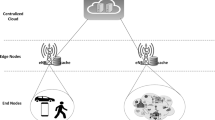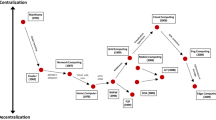Abstract
As laptop computers begin to dominate the marketplace, wireless adapters with varying bandwidth and range capabilities are being developed by hardware vendors. To provide multihop communication between these computers, ad hoc mobile networking is receiving increasing research interest. While increasing a node's transmission range allows fewer hops between a source and destination and enhances overall network connectivity, it also increases the probability of collisions and reduces the effective bandwidth seen at individual nodes. To enable formation of multihop ad hoc networks, a routing protocol is needed to provide the communication and route finding capability in these networks. The Ad hoc On-Demand Distance Vector Routing protocol (AODV) has been designed to provide both unicast and multicast communication in ad hoc mobile networks. Because AODV uses broadcast to transmit multicast data packets between nodes, the transmission range plays a key role in determining the performance of AODV. This paper studies the effects of transmission range on AODV's multicast performance by examining the results achieved at varying transmission ranges and network configurations.
Similar content being viewed by others
References
L. Bajaj, M. Takai, R. Ahuja, K. Tang, R. Bagrodia and M. Gerla, GloMoSim: A scalable network simulation environment, Technical report No. 990027, CSD, UCLA, 1997.
J. Broch, D.A. Maltz, D. Johnson, Y.-C. Hu and J. Jetcheva, A performance comparison of multi-hop wireless ad hoc network routing protocols, Proceedings of the 4th Annual ACM/IEEE International Conference on Mobile Computing and Networking (MobiCom), Dallas, TX (October 1998) pp. 85–97.
S.R. Das, C.E. Perkins and E.M. Royer, Performance comparison of two on-demand routing protocols for ad hoc networks, in: Proceedings of the IEEE Conference on Computer Communications (INFOCOM), Tel Aviv, Israel (March 2000) pp. 3–12.
L. Feeney, An energy consumption model of performance analysis of routing protocols for mobile ad hoc networks, Mobile Networks and Applications 6(3) (2001) 239–249.
J.J. Garcia-Luna-Aceves and E.L. Madruga, A multicast routing protocol for ad-hoc networks, in: Proceedings of the IEEE Conference on Computer Communications (INFOCOM), New York (March 1999) pp. 784–792.
IEEE, Wireless LAN Medium Access Control (MAC) and Physical Layer (PHY) specifications, IEEE Standard 802.11-1997 (1994).
L. Ji and M.S. Corson, A lightweight adaptive multicast algorithm, Proceedings of IEEE GLOBECOM, Sydney, Australia (December 1998) pp. 1036–1042.
P. Johansson, T. Larsson, N. Hedman, B. Mielczarek and M. Degermark, Scenario-based performance analysis of routing protocols for mobile ad-hoc networks, in: Proceedings of the 5th ACM/IEEE International Conference on Mobile Computing and Networking (MobiCom), Seattle, WA (August 1999) pp. 195–206.
S.-J. Lee, M. Gerla and C.-C. Chiang, On-demand multicast routing protocol, in: Proceedings of the IEEE Wireless Communications and Networking Conference (WCNC), New Orleans, LA (September 1999) pp. 1298–1304.
V.D. Park and M.S. Corson, A highly adaptive distributed routing algorithm for mobile wireless networks, in: Proceedings of the IEEE Conference on Computer Communications (INFOCOM), Kobe, Japan (April 1997) pp. 1405–1413.
C.E. Perkins and E.M. Royer, Ad-hoc on-demand distance vector routing, in: Proceedings of the 2nd IEEE Workshop on Mobile Computing Systems and Applications, New Orleans, LA (February 1999) pp. 90-100.
C.E. Perkins, E.M. Belding-Royer and S.R. Das, Ad hoc On-Demand Distance Vector (AODV) Routing, IETF Internet Draft, Work in Progress, draft-ietf-manet-aodv-11.txt (June 2002).
R. Ramanathan and R. Rosales-Hain, Topology control of multihop wireless networks using transmit power adjustment, in: Proceedings of the IEEE Conference on Computer Communications (INFOCOM), Tel Aviv, Israel (March 2000) pp. 404–413.
T.S. Rappaport, Wireless Communications, Principles & Practices, (Prentice Hall, 1996) chapter 3, pp. 70–74.
E.M. Royer, P.M. Melliar-Smith and L.E. Moser, An analysis of the optimum node density for ad hoc mobile networks in: Proceedings of the IEEE International Conference on Communications (ICC), Helsinki, Finland (June 2001) pp. 857–861.
E.M. Royer and C.E. Perkins, Multicast operation of the ad-hoc ondemand distance vector routing protocol, in: Proceedings of the 5th ACM/IEEE International Conference on Mobile Computing and Networking (MobiCom), Seattle, WA (August 1999) pp. 207–218.
F.A. Tobagi and L. Kleinrock, Packet switching in radio channels. Part II – The hidden terminal problem in carrier sense multiple access models and the BusyTone solution, IEEE Transactions on Communications 23(12) (December 1975) 1417–1433.
Rights and permissions
About this article
Cite this article
Belding-Royer, E.M., Perkins, C.E. Transmission Range Effects on AODV Multicast Communication. Mobile Networks and Applications 7, 455–470 (2002). https://doi.org/10.1023/A:1020708701096
Issue Date:
DOI: https://doi.org/10.1023/A:1020708701096




